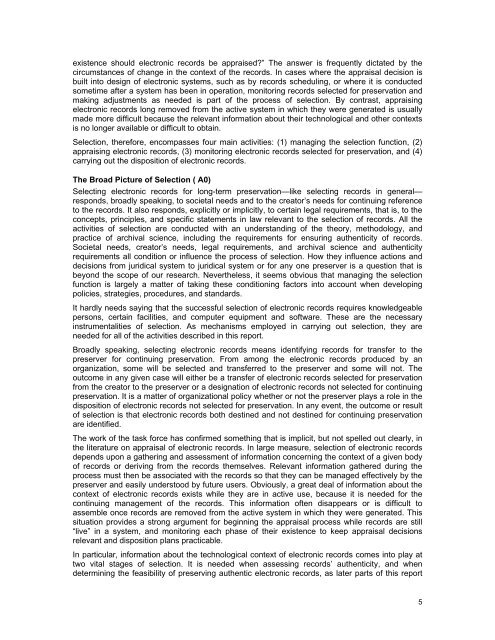Appraisal Task Force Report - The InterPARES Project
Appraisal Task Force Report - The InterPARES Project
Appraisal Task Force Report - The InterPARES Project
You also want an ePaper? Increase the reach of your titles
YUMPU automatically turns print PDFs into web optimized ePapers that Google loves.
existence should electronic records be appraised?” <strong>The</strong> answer is frequently dictated by the<br />
circumstances of change in the context of the records. In cases where the appraisal decision is<br />
built into design of electronic systems, such as by records scheduling, or where it is conducted<br />
sometime after a system has been in operation, monitoring records selected for preservation and<br />
making adjustments as needed is part of the process of selection. By contrast, appraising<br />
electronic records long removed from the active system in which they were generated is usually<br />
made more difficult because the relevant information about their technological and other contexts<br />
is no longer available or difficult to obtain.<br />
Selection, therefore, encompasses four main activities: (1) managing the selection function, (2)<br />
appraising electronic records, (3) monitoring electronic records selected for preservation, and (4)<br />
carrying out the disposition of electronic records.<br />
<strong>The</strong> Broad Picture of Selection ( A0)<br />
Selecting electronic records for long-term preservation—like selecting records in general—<br />
responds, broadly speaking, to societal needs and to the creator’s needs for continuing reference<br />
to the records. It also responds, explicitly or implicitly, to certain legal requirements, that is, to the<br />
concepts, principles, and specific statements in law relevant to the selection of records. All the<br />
activities of selection are conducted with an understanding of the theory, methodology, and<br />
practice of archival science, including the requirements for ensuring authenticity of records.<br />
Societal needs, creator’s needs, legal requirements, and archival science and authenticity<br />
requirements all condition or influence the process of selection. How they influence actions and<br />
decisions from juridical system to juridical system or for any one preserver is a question that is<br />
beyond the scope of our research. Nevertheless, it seems obvious that managing the selection<br />
function is largely a matter of taking these conditioning factors into account when developing<br />
policies, strategies, procedures, and standards.<br />
It hardly needs saying that the successful selection of electronic records requires knowledgeable<br />
persons, certain facilities, and computer equipment and software. <strong>The</strong>se are the necessary<br />
instrumentalities of selection. As mechanisms employed in carrying out selection, they are<br />
needed for all of the activities described in this report.<br />
Broadly speaking, selecting electronic records means identifying records for transfer to the<br />
preserver for continuing preservation. From among the electronic records produced by an<br />
organization, some will be selected and transferred to the preserver and some will not. <strong>The</strong><br />
outcome in any given case will either be a transfer of electronic records selected for preservation<br />
from the creator to the preserver or a designation of electronic records not selected for continuing<br />
preservation. It is a matter of organizational policy whether or not the preserver plays a role in the<br />
disposition of electronic records not selected for preservation. In any event, the outcome or result<br />
of selection is that electronic records both destined and not destined for continuing preservation<br />
are identified.<br />
<strong>The</strong> work of the task force has confirmed something that is implicit, but not spelled out clearly, in<br />
the literature on appraisal of electronic records. In large measure, selection of electronic records<br />
depends upon a gathering and assessment of information concerning the context of a given body<br />
of records or deriving from the records themselves. Relevant information gathered during the<br />
process must then be associated with the records so that they can be managed effectively by the<br />
preserver and easily understood by future users. Obviously, a great deal of information about the<br />
context of electronic records exists while they are in active use, because it is needed for the<br />
continuing management of the records. This information often disappears or is difficult to<br />
assemble once records are removed from the active system in which they were generated. This<br />
situation provides a strong argument for beginning the appraisal process while records are still<br />
“live” in a system, and monitoring each phase of their existence to keep appraisal decisions<br />
relevant and disposition plans practicable.<br />
In particular, information about the technological context of electronic records comes into play at<br />
two vital stages of selection. It is needed when assessing records’ authenticity, and when<br />
determining the feasibility of preserving authentic electronic records, as later parts of this report<br />
5


